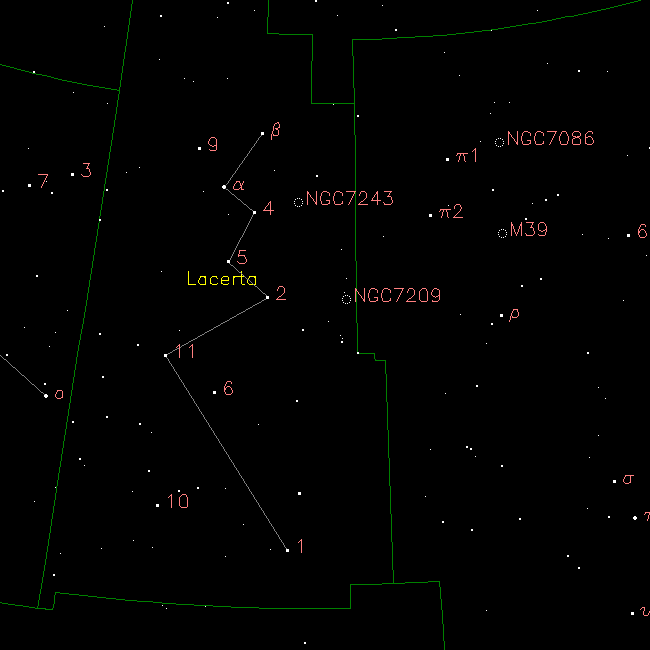[/caption]
The constellation of Lacerta is unusual, because it did not belong orignally to those created by Ptolemy – but to the works of Johannes Hevelius. Lacerta was included in Firmamentum Sobiescianum, a 56 page atlas created by Hevelius, which outlined seven new constellations which survived time – and many which did not. Positioned north of the ecliptic plane, it spans 201 square degrees of sky and contains 5 main stars in its asterism and 17 Bayer/Flamsteed designated stars within its boundaries. Lacerta is bordered by the constellations of Andromeda, Cassiopeia, Cepheus, Cygnus and Pegasus. It is visible to all observers at latitudes between +90° and ?90° and is best seen at culmination during the month of December.
Since Lacerta is considered a “modern” constellation, there is no mythology associated with it – although the stellar pattern was very visible to the ancient Greeks and Romans. At the time, Native American culture was highly regarded and the Chusmash of the California region referred to this area of the sky as the “Lizard”. Perhaps Hevelius honored their many stories and their culture by adopting the Latin term for lizard – Lacerta – and placing it upon this constellation.
Although Lacerta contains no bright stars, once you pick out its dim lightning bolt pattern of stars you’re well on the way to exploring with binoculars or a telescope. A sure way to help locate it is to wait for a dark night and scan the sky between Cassiopeia and Cygnus. When you’re ready, let’s take a look at Alpha Lacertae – the “a” symbol on our map. While it is just a rather ordinary A-class star residing about 102 light years away from our solar system, Alpha is about twice the size of our Sun and shines about 27 more brightly. Take a look through a telescope and you will see that Alpha appears to have a companion, but it is only an optical double star. The 11.8 magnitude line of sight interloper is really almost 2600 more light years away!
Now hop to Beta Lacertae – the “B” symbol on our map. Located about 170 light years from Earth, Beta is a giant yellow star, similar in some ways to our own Sun, but far more massive. If you’re seeing a field of stars to the west/southwest of Beta in binoculars, you’d be correct. Positioned about 2.6 degrees away from Beta is loose open cluster NGC 7243, also known as Best 59 or Caldwell 16. It contains about 40 stars and is spread out over a very large area which makes it a nice binocular object. If you’ve got the magnification power of a telescope on it, be sure to check out the brightest star in the cluster. Its name is Struve 2890 and it’s a great double star! For a telescope viewing challenge, look about 2 degrees west/northwest of Beta for IC 1434 – another open cluster. At magnitude 10, the small compressed beauty is meant for larger optics!
For another great rich field telescope treat, aim your sights towards NGC 7209 (RA: 22h 05m 12.0s Dec.:+46 29’ 59”). At a comfortably bright magnitude 7.7, this galactic star cluster is well compressed and very rich in stars. Also known as Collinder 444 and Melotte 238, this stellar beauty has been studied photometrically for reddening and metallicity, as well as the presence of suspected binary stars. Viewable in binoculars as a dim, hazy patch and well resolved in the telescope.
For binary star fans, have a look at 8 Lacerta (RA 22h 35m 52.28s Dec.: +39d 38’ 03.6”). Here you’ll find a beautiful multiple star system that’s also on the Astronomical League 100 list. In the telescope eyepiece, look for a 5.7 magnitude primary star accompanied by a 6.5 secondary star separated by about 22″. Further away you’ll find the 7.2 magnitude C star separated by about 82″. It’s very worthy of your time and attention!

